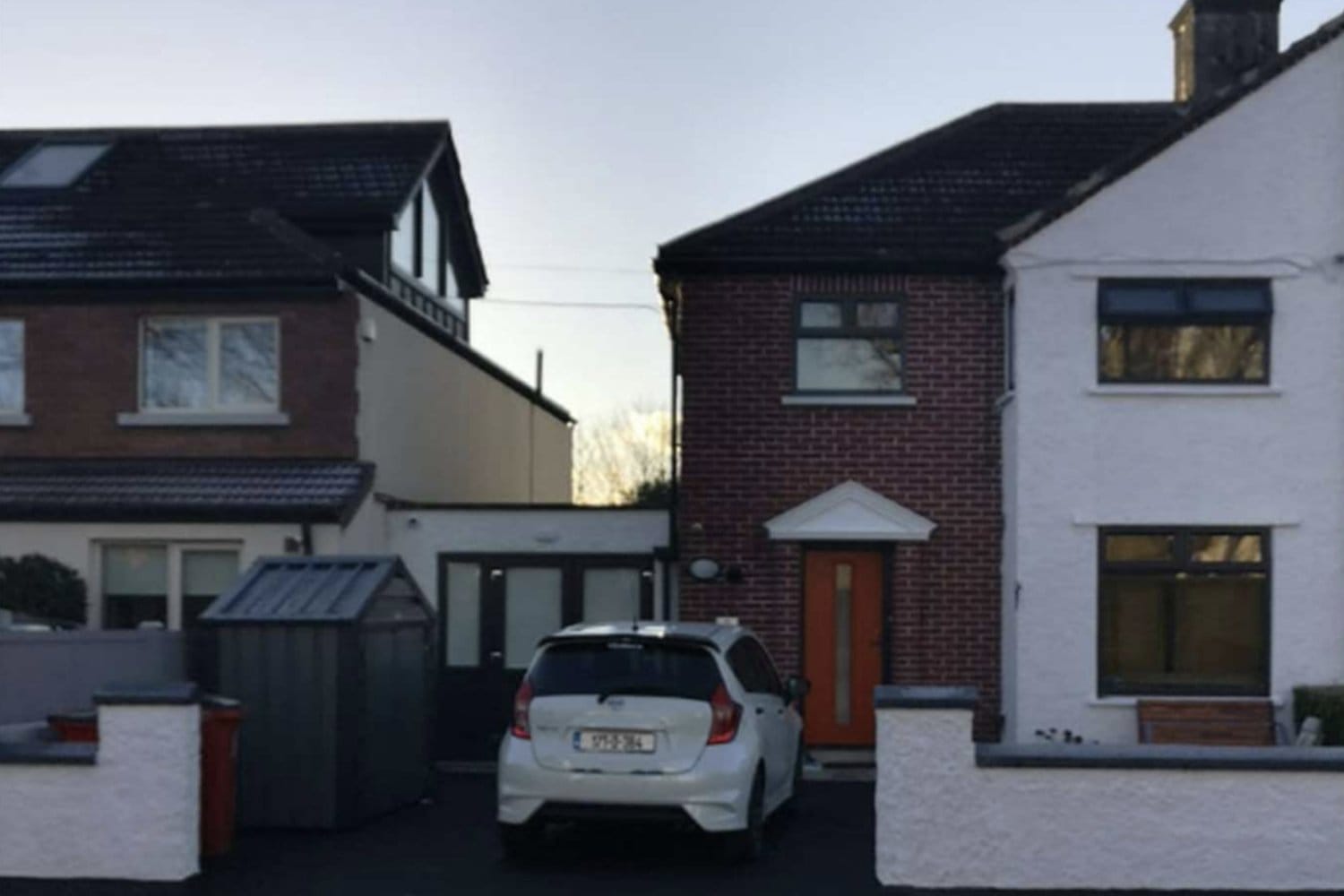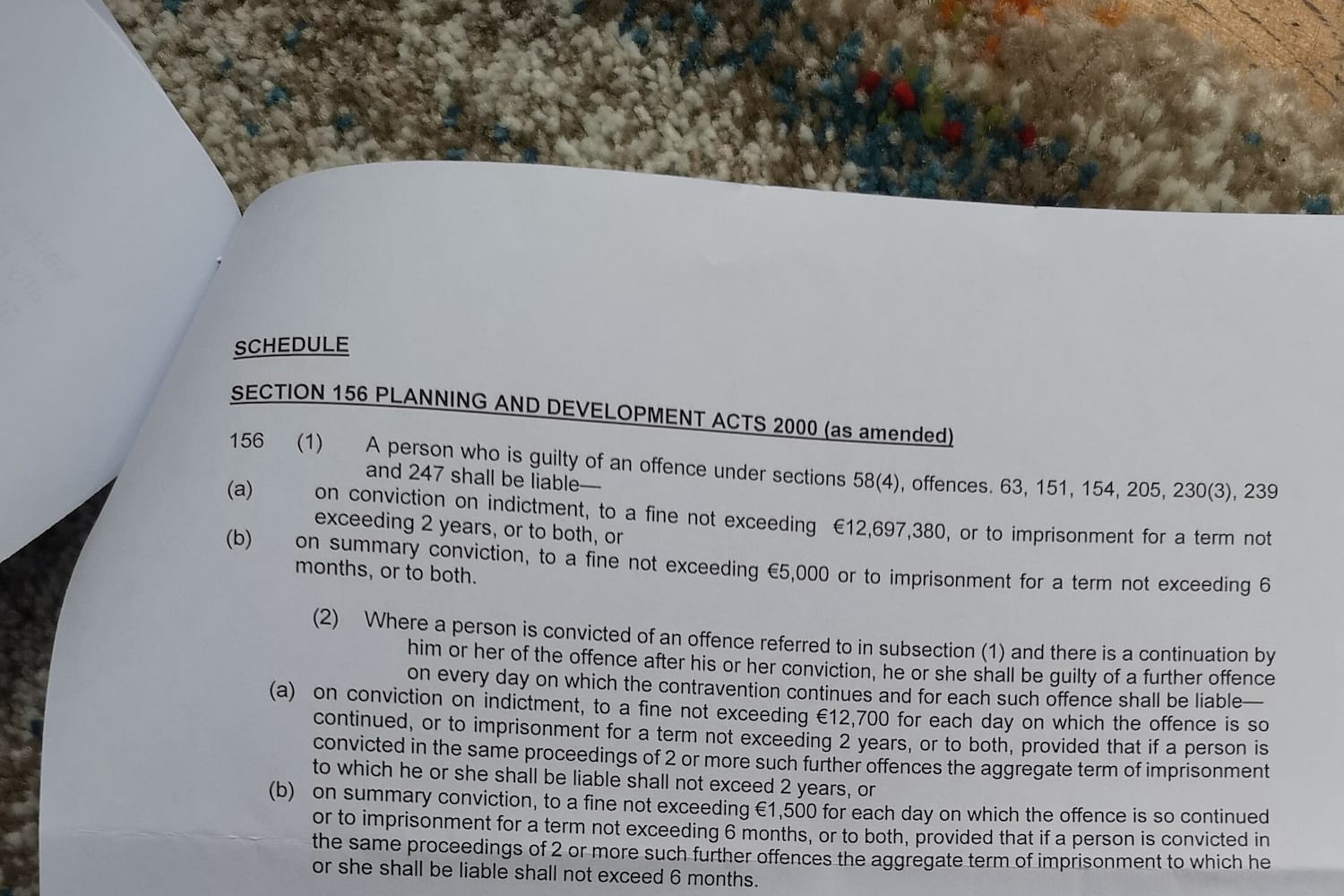What’s the best way to tell area residents about plans for a new asylum shelter nearby?
The government should tell communities directly about plans for new asylum shelters, some activists and politicians say.
As years have passed and the council has not rolled out its proposed 350 bike bunkers, people have been finding their own solutions – but planning is a barrier.

Siobhan Kelly was surprised to get a letter from Dublin City Council telling her she had to remove the secure, covered bike storage she’d put in her front garden.
“This is just bananas,” said Kelly, who lives in a house in Clontarf.
She and her 14-year-old son both cycle. He uses his bike for everything, she says, and she uses hers often to visit her mother in a care home on Griffith Avenue.
“It’s kind of good for that and it means I’m using the car less and less petrol and all that kind of stuff,” she says.
At both national and local levels, there are government policies pushing people to use their cars less and walk, cycle or take public transport more – to reduce traffic, pollution, and carbon emissions, given the climate crisis.
“How can you expect people to make that change? They need to have somewhere safe and secure and convenient to be able to store their bicycles in order to use bicycles,” says Green Party Councillor Donna Cooney.
Yet, the council’s own efforts to provide people a safe place to park their bikes near their homes have stalled.
The council started testing secure, covered “bike bunkers”, where residents could rent spaces as far back as 2014. For years, a plan to roll out 350 of them was coming soon. Now it looks like that’s delayed indefinitely.
Meanwhile, given what Fine Gael Councillor Ray McAdam recently called the council’s “absolute failure to advance the scheme”, residents like Kelly have been making their own private arrangements.
“We need the bike lockers,” Kelly says. “I mean if it’s on somebody’s, you know, within their own boundary, what is the problem?”
Kelly said she and her son wanted a convenient place to store their bikes, as well as a wheelchair and zimmer frame for when she brings her mother home to visit from the care home.
“They would definitely be robbed. I mean, we live in Clontarf, so it’s a nice area and everything, but still,” she said.
So she researched the planning regulations and asked the council about them and concluded that she could put secure bike storage in her front garden without applying for planning permission.
After all, she says, other people up and down the estate have various structures in their front gardens. So why can’t she?
Then, in a 10 January letter, the council wrote to her, saying they’d heard about “unauthorised development” on her property and were looking into it. “It is alleged that a shed has been erected in the front garden,” the letter says.
They wrote again on 27 March to say they’d concluded she’d broken the planning rules and has to remove the bike storage – they call it a shed, she says it’s a temporary bicycle storage locker – by 30 June.

The letter also said she was required to pay the cost of their investigation, and included a page detailing the possible consequences of being convicted of a planning offence, such as a fine of up to €12,697,380 or “imprisonment for a term not exceeding 2 years”.

Kelly replied to the council in an 11 April letter. “The threats of costs, legal costs, fines and imprisonment are beyond what could be considered reasonable even if your notice was correct.”
“Such storage lockers are present in every other front garden across the city and county. Therefore how could my storage locker be offending when all of these others are present and plain to see?” she wrote.
Feeling singled out for punishment, Kelly submitted complaints to the council about structures in other people’s front yards.
In fact, she submitted 107 complaints about “structures of various sizes, designs and locations, sited to the front of residential properties in the Dublin 3 area”, says an email from a council planning enforcement manager to her on 25 April.
The council decided these were “vexatious”, declining to pursue any of them, the letter said. But it’s still pursuing the complaint against Kelly.
At a meeting of the council’s planning committee on 27 April, Cooney, the Green Party councillor, proposed a motion to support the use of front-garden bike shelters.
Since council policy and the city development plan favour the use of “active transport”, meaning cycling and walking, “for a healthy city, a sustainable city and for climate action”, more citywide bike parking is needed too, it says.
So the council should “find a way to facilitate through planning, more citywide secure bike parking, through exempted development”, meaning it wouldn’t require planning permission, “in change of use of buildings for indoor bike parking and the use of design guided bike bunker/bike shelters in front gardens”.
Since the council hasn’t rolled out the planned bike bunker programme, it should make it easier for people to put in their own secure, covered bike parking in their front gardens, she said.
After all, Cooney said Monday on the phone, “they’re allowing six carports and like home gyms at the front of people’s houses”. The council’s planning rules in this case are working against its climate-action policies, she said.
It’s not the council’s fault, Deputy City Planning Officer Deirdre Scully said at the recent planning committee meeting.
“The problem for us as a planning authority, is that at the moment the regulations are very strict about what goes in front of the house, which doesn’t give us a lot of scope in interpretation of the regulations,” she said.
Allowing front-garden bike lockers would require changes to national planning law, Scully said. She suggested the committee write to the minister.
The committee supported Cooney’s motion and decided to do just that.
But Labour Councillor Dermot Lacey said the issue shouldn’t require national legislation.
“This notion that, you know, the mandarins in the Custom House will decide how I park my bike, it’s just stupid,” Lacey said. “These are decisions that should be made at a local level, that we can work out – we have great planners in Dublin City Council.”
Fine Gael Councillor Naoise Ó Muiri, who also has been raising the issue, said by phone Monday that the council should just handle the issue itself.
“It seems that everybody’s pointing somewhere else. It seems to be talking about central government and, you know, the current environment in terms of regulations,” he said.
“I think we should just vary the development plan and make it clear that we support those bike boxes,” said Ó Muiri
Not everyone, though, has a front garden to put a bike box or locker or whatever into.
Darran Lovely, for example, lives in a terraced house in Drumcondra and doesn’t have a place to put one on his property, he says.
So he’s thinking of organising some of his neighbours and together installing a large shared bike locker in a street parking spot around the corner, which isn’t paid parking, and isn’t in front of anyone’s house.
“At the moment I have to bring it [his bike] in my front door, into the hall, into the living room and kind of stick it under the stairs,” he says. “So it’s not ideal.”
He said he got really excited when he saw the pilot project years ago to try out bike bunkers. “It’s such a simple solution to, you know, one of our climate targets, you know, getting more bikes on the road, getting more cars off.”
He got a group of people together to apply for one, but the council didn’t pick them. “I think they only had about 12 for the whole city,” he said.
This was followed by a council announcement that they would roll out 350 of them across the city – and a call for further applications.
But at the council’s April monthly meeting, Patricia Reidy, a senior engineer with Dublin City Council, said that the council is no longer sure about whether it will roll out the bike bunkers at all. “The scheme itself is being reviewed.”
The council has not explained the apparent shift in policy, and has not replied to a query about it sent Monday. “We have been trying to find out what’s going on and we’re not getting anywhere,” said Cooney, the Green Party councillor. “It’s very frustrating.”
Lovely is now mulling over whether to take matters into his own hands. “I mean, I’m obviously quite hesitant to actually go ahead and do this because this is illegal at the moment. You don’t want to invest in something that could get taken away,” he said.
But he’s frustrated with waiting and doesn’t see why he shouldn’t be able to do it himself, if the council’s not going to.
When he gutted and renovated his house, they put a port-a-loo in a street parking spot for nine months for the people doing the work to use, and that was no problem, Lovely says. And a bike bunker’s a lot nicer thing to have there than a toilet, he says.
“My next step is just to see whether there’s any action from DCC [Dublin City Council], whether they come out with some specific plan over the next few weeks,” he said.
Darran Lovely’s sister, Andrea Lovely, who shares the house with him, says she’d bring her bike up from their parents’ house if there was a good place to keep it at theirs.
“I often end up taking the bus or driving rather than hopping on a bike which in many cases would be much faster as well as healthier and better for the environment,” she says.
Bike boxes and lockers and bunkers are expensive, costing, depending on the model, from several hundred euro to several thousand. Many don’t have the cash for that.
So, says Ó Muiri, the Fine Gael councillor, why not expand the cycle-to-work scheme to cover them? “No reason why we couldn’t look at expanding that to contain storage.”
Under the scheme, an employer can buy a bike and their employee can pay it back over time at a discount thanks to tax relief.
What about those who don’t have space, or don’t have an employer to help them take advantage of a new safe-cycle-storage scheme?
What if everyone were within very short walking distance of a shared bike? Cooney suggests.
“I can come out the door and there’s bikes for hire at a very low cost, you know, even subsidised for those on a low income,” she says. “So you don’t even have to own a bicycle yourself.”
Whatever the solutions, they should be brought in swiftly, unlike the council’s bike bunker programme, Cooney says.
That solution was piloted nearly a decade ago, and has only scaled up from idea to 12 bunkers over that time.
“We all are in a climate crisis and we need to start acting like we’re in a crisis. And we don’t have long to do these things,” Cooney says.
UPDATE: This article was updated at 13.38 on 17 May to include another photo of Siobhan Kelly’s front garden with the bike storage.
Get our latest headlines in one of them, and recommendations for things to do in Dublin in the other.